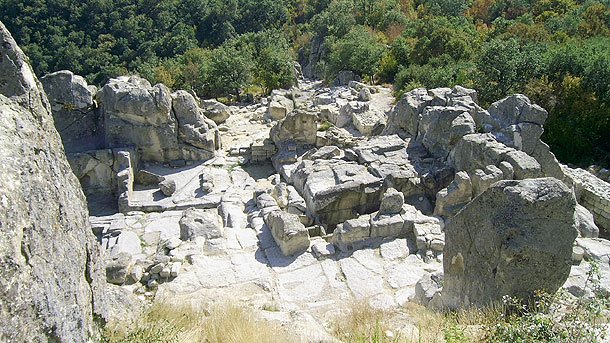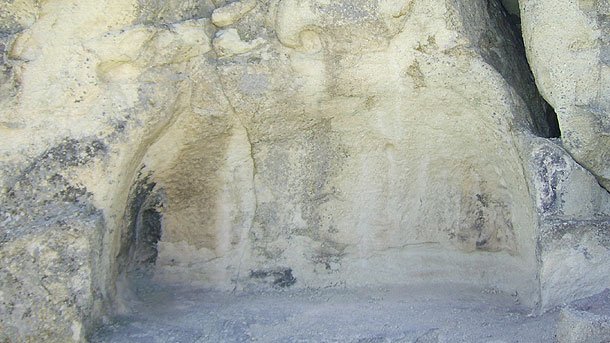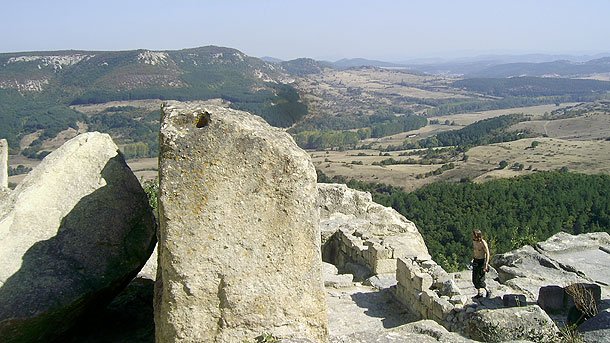Perperikon is situated at 470 meters altitude near the town of Kardzali, Southeastern Bulgaria. Hewn into the rocks, it is now one of the oldest big monuments. It embodies the history of this region from several epochs. According to scientists, the famous sanctuary of God Dionysus was at this place and all prophecies made there became true. This is why many renowned people from the past turned to the priestesses, who were conducting the wine and fire rituals.
The name of the ancient religious center comes from the Old Greek language. The word Hyperperakion means a huge fire. It gave the name of the golden coin with big gold content, which was minted in Byzantium in 1082. Historians explain the connection between the name of the coin and the rock monument with the local gold deposits. The gold mines, where the Thracians and later the Byzantine people used to extract gold recline 2 kilometers from the rocky town. Soon after the monetary reform this sophisticated word was made shorter. This is how the final word Perperikon emerged. It still remains a secret how this place was called in the old ages.

© Photo: Albena Bezovska
The first evidence of life dates back to the Late Stone Age (the Neolithic age) - at the end of the 6th and the beginning of the 5th millennium BC. During this early period this place was a subject of deify. The end of the Stone-copper age is the next historical period, which provides evidence, saying that this big stone massif was a religious place. The first sanctuary was the one of the Sun-God. It is situated next to the so-called oval hall, where the sanctuary of God Dionisius was built later at this place.
“After the wine was spilt onto the altar, the smoke rose up above the top of the shrine and even unto heavens as had happened when Alexander the Great had sacrificed upon the same altar”. This phrase comes from the book” Chronicles of the Roman Emperors” written by Gaius Suetonius Tranquillus ages ago. It tells the story of a prophecy, made to the request of Emperor Octavian, the father of Augustus, who later became Emperor of Rome. According to the chronicler Octavian was crossing the outlying parts of his empire and when he came upon the holy Mount of God Dionysus he consulted the oracle about his son. The prophets said to him son was to rule the world.”
This written proof was mentioned by the historians many times. Visitors can learn about this from the tour guides if they decide to climb the steep path. The whole trip lasts for 1.5 hours. It must be done when the weather is good- at moderate temperatures and dry weather.

© Photo: Albena Bezovska
Each step made in Perperikon reveals part of its boundless history. One can see there the well preserved rooms dating to the Thracian period. Most remarkable of all are the three floors of the religious complex, dedicated to God Dionysus. Well preserved stone benches and staircase can be seen there. The stone throne, engraved high up in the rocks can be seen at the place which is lit by the sun through the whole day. The sanctuary itself is situated at the last floor. It was the place where the wine and fire rituals took place. It is 3 meters high and 2 meters wide. During the first excavations in the 1980’s the team led by the renowned archeologists Ivan Balkanski found a stone sarcophagus. Its weight was nearly 2 tons. Despite of its huge weight and size it was immediately lifted by a helicopter. It still remains a secret what was inside this sarcophagus and where it was transported. This will probably remain a secret forever.

© Photo: Albena Bezovska
Tens of stone tubs were scattered across the whole region. These tubs were used for the making of wine, which was later used in the religious rituals.
“In the bottom left corner of this tub you can see a stone groove, through which the ritual liquid was flowing out", Milen Filipov explains. "We call these tubs “sharapans”. We do not know how the ancient Greeks were calling them. However, judging by their number and size we can tell that great quantities of wine were produced there. Recently a huge number of well preserved clay jars were found. The bigger ones were used to hold wheat and the small ones used to hold wine”, says Milen Filipov.
During the pagan period of the Roman Empire this sanctuary was alive. Its owners were members of the Thracian tribe Bessy, who were in alliance with the Roman people. In 393-398 the Bessy people were converted. The sanctuary became useless and turned into an obstacle to the promotion of the new religion. Later the sanctuary was covered with soil. Thus, a great favor was made to the scientists of the 19th century as the soil layer preserved well the ritual building.

© Photo: Albena Bezovska
A temple of an early Christian type was built at the end of the 4th century, which was recently discovered as well. Its ceramic altar was very well preserved. A copy of this altar can be seen in the premises of the church there. The original alter is kept in the Regional Museum of History in the town of Kardzali. People can see there many ancient objects from different periods, found in this region. “Perperikon is an incredible place which emits huge amounts of energy”, says Milen Filipov.

© Photo: Albena Bezovska
“Many people talk about the energy of this place. I feel this energy myself”, says Milen Filipov. “Of course it can be felt by people with high sensitivity. The scientists are discussing this issue as well. Some say that this place has a specific cosmic energy. Others say that this is due to the high copper content in the rocks. This explains why so many religious ceremonies took place there over the centuries until the Ottoman invasion, when life in Perperikon died away”, Milen Filipov concluded.
English version: Kostadin Atanasov
The Regional Museum of History in Turgovishte in the old, Revival-time part of town, called Varosha, houses over 30,000 exhibits. Some of the artifacts, discovered by archaeologists in these parts, go as far back as the Neolithic age. The..
The house of Vasil Levski, Bulgaria’s national hero and organizer of the anti-Ottoman movement in the 19th c. has always been one of the most visited memorial museums in this country. The building itself is modest and its style is typical for..
In Bulgaria’s Northwestern corner a fantastic rocky landscape meets the eye – the towering Belogradchik rocks inspire awe and deference in any onlooker. The area is studded with yawning abysses, canyons and caves, gateways to the kingdom of..

+359 2 9336 661
